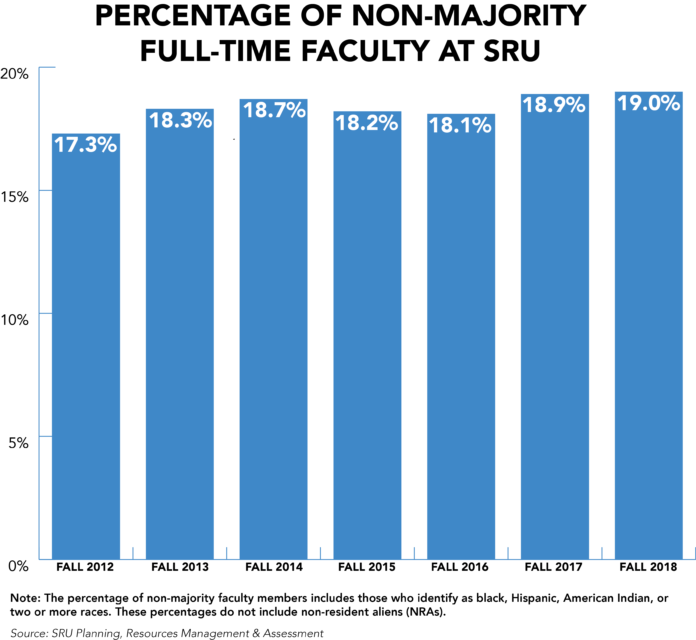When a community member questioned SRU President William Behre about the diversity of SRU’s faculty and staff at a townhall on Feb. 18, his initial answer was simple, and was met with applause: “Not diverse enough.”
“I can’t speak to the past because I wasn’t here for the past, but we do have to make a concerted effort in our searches to diversify our faculty and staff,” Behre, who became president on July 1, 2018, added. Behre hosted the town hall, which had an audience of over 600 students, faculty and community members, in response to the discovery of vandalized Black History Month flyer in a residence hall.
In fall 2018, 19 percent of SRU’s full-time employees identified themselves as non-majority or non-Caucasian, the highest percentage of ethnically diverse faculty at SRU within the past seven years. This makes SRU the second most diverse school in the Pennsylvania State System of Higher Education (PASSHE), following Cheyney University, a historically black college where 64.4 percent of its faculty identify as black or African American, according to College Factual. The national percentage of non-majority faculty in higher education is 22 percent, according to the National Center for Education Statistics.
Kennedy Moore, a 21-year-old senior resort recreation and hospitality major and vice president of diversity and inclusion of the Student Government Association (SGA), said that the ethnic diversity of faculty is lacking, but is representative of the student body. In the fall 2018 SRU student profile, 14.4 percent of the student body identified as non-majority. In Pennsylvania, 28.5 percent of students identified as non-majority compared to 43.2 percent nationwide in fall 2016, according to Digest of Education Statistics.
“There are not a lot of students of color or Hispanic students here, so I definitely think the ratio in terms of students and faculty and staff lines up,” said Moore, who also serves as a student representative on the President’s Commission for Racial and Ethnic Diversity (PCRED).
Dr. Philip Way, SRU’s provost and vice president for academic and student affairs, said that part of the university’s strategic plan outlines approaches to increase diversity of faculty and staff. Goal six of SRU’s strategic plan states that the university will “attract, retain and develop highly qualified and diverse faculty, staff and administrators.” Specific steps include training those in charge in hiring and recruitment, making SRU an attractive workplace and developing employees to help them be more successful in their roles.
“We have a goal that we not only want quality faculty, but we want diverse faculty, too,” Way said.
For search committees, the recruitment process is broken into two parts: forming a pool of candidates, and deciding who gets an interview. The search committee oversees the initial application and interview processes, but the dean of the academic college and provost will make the final decision as to who is hired.
Dr. Ben Shaevitz, associate physics and engineering professor and president of SRU’s Association of Pennsylvania State College and University Faculties (APSCUF) chapter, said APSCUF created the procedure for hiring in its collective bargaining agreement, but search committee members don’t need to be union members.
“In terms of the wording of the position announcement, what the specialty is, all the requirements and then voting on the candidates that are acceptable—it’s done by the whole department,” Shaevitz said. “The committee doesn’t have the power. They’re just the workers.”
Holly McCoy, assistant vice president of diversity and equal opportunity, said search committees must submit a diversity and recruitment plan as part of a position announcement. McCoy assists by offering ideas to each committee to complete this part of the plan.
“We’re really trying to focus on expanding the diversity recruitment plans not to so much be for a single search, but really to have departments trying to think more globally about building relationships,” McCoy said. “Sometimes when you have a position to post, the idea is ‘You have to get the position filled quickly,’ which is understandable. They’re worried about being without faculty.”
McCoy said most plans include where the committee will advertise the position. In addition to JobElephant, a recruitment advertising website, some of SRU’s positions have been advertised through The PhD Project, a non-profit that encourages underrepresented minority students to earn graduate and doctoral degrees in business and become professors, and Diverse Issues in Higher Education, which lists job postings on its website.
SRU’s chapter of the Black Faculty and Staff Association (BFSA), a 25-member organization that provides recommendations to administration concerning issues affecting African American administrators, faculty, staff and students, is actively involved in the job-posting process.
BFSA members recently created a strategic plan to get more involved in diversifying SRU’s campus, according to its president, Torry Rollins. In fall 2018, 3.9 percent of SRU’s full-time faculty identified as black according to instructional data from SRU’s Office of Planning, Resources Management and Assessment.
As part of its connections with President Behre, BFSA ensures that job postings reach diverse populations.
“By saying that, that meant making sure postings are posted in the proper vehicles for recruiting diverse populations and also, once those diverse applicants arrive on campus, being a welcoming committee for those individuals who come to campus,” Rollins, who also serves as associate athletic director, said. “That’s our way of assisting the university to help diversify its faculty and staff.”
Corinne Gibson, vice president of BFSA and co-chair of PCRED, said the current response to job positions is to be reactive to unfulfilled openings, but the university’s response needs to be more proactive.
“However, we’re trying to be proactive as to actually looking for people who are looking for jobs and trying to bring them to Slippery Rock,” Gibson said. “That, to me, is one area where we can improve on.”
College deans and faculty who attend conferences also connect with possible job applicants. As one example, McCoy attends the Southern Regional Education Board conference annually, and encourages doctoral students from those 16 member states to apply for a position at SRU.
According to Mary Hennessey, assistant to the provost, there is no concrete data on the effectiveness of this type of outreach, because applicants are not required to reveal how they found the position.
“One of the issues we have is that we can ask candidates how they found out about the job, but they don’t have to answer that, so we have really shaky data on how they came to Slippery Rock,” Hennessey said. “That’s one of the more frustrating things about the process, because the candidates have a right to privacy, too. We can ask them questions and they don’t have to answer them. Sometimes, it’s hard when we talk about the diversity pool and things like that—that’s all voluntary information.”
Once McCoy approves the position announcement, the committee will search for a diverse pool of candidates. From there, search committee members will select at least three applicants for an on-campus interview.
APSCUF President Shaevitz said procedures must be consistent between all interviews.
“You’re really careful about doing things fairly and equally to everybody,” Shaevitz said.
Following the interview, the dean and McCoy will review the advertised minimum requirements for the position and the specific reasons why a candidate was not recommended to be hired, to ensure objectivity.
“A large part of my job in terms of searches is that I’m trying to create as much objectivity in what can be a very subjective process, so we want to make sure we have a process and that we’re following our process for all these searches,” McCoy said.
According to SRU President Behre, although Pennsylvania is a diverse state, the western region doesn’t reflect this diversity.
“I’ve heard from many people that our location in Western Pennsylvania, with the region’s current ethnic and religious homogeneity, makes attracting non-majority faculty, staff and students a challenge,” Behre wrote in a memo to staff at the beginning of the fall 2018 semester. “This may be true. Still, we must remember that a challenge is not necessarily an impossibility.”
Provost Way said the demographics of western Pennsylvania make marketing job positions toward non-majority applicants a priority.
“That’s another thing that’s interesting about this whole subject—how do you recruit people of color to come to basically a Caucasian county?’” Way said. “You have to adopt marketing efforts to say that there are diversity efforts.”
When breaking down ethnicity into SRU’s academic colleges, the most diverse college is the College of Business, at 32.7 percent, followed by the College of Liberal Arts (18.4 percent), the College of Health, Environment and Science (17.1 percent) and the College of Education (12.7 percent), according to instructional data from SRU’s Office of Planning, Resources Management and Assessment.
Dr. Roger Solano, associate professor in the School of Business and co-chair of the Hispanic Latino Culture Series committee, said the College of Business is more competitive, but still ensures a diverse pool by reaching out to diverse populations.
“There are departments that are more committed to diversity than others,” Solano said. “One of the hardest areas to hire in the whole university is business. Business is very competitive to hire, and we make a very strong effort to make sure that our recruitment efforts reach the diverse population. If we are able to do it, everyone should be able to do it.”
Across the four academic colleges, 12 departments reported no non-majority full-time faculty in fall 2018: safety management, special education, exercise and rehabilitation science, occupational therapy, parks and conservation, recreational therapy, physician assistant studies, psychology, history, homeland/corporate security studies, music and political science.
Behre noted that faculty members who start in temporary positions may apply for a permanent position later in their time at SRU; however, the likelihood of an applicant moving to a new area for a temporary job is lower than if the applicant is seeking a permanent position. As a result, possible candidates who don’t currently live close to SRU are less likely to apply for a temporary position.
“If you’re a temporary faculty member and you’re hired on a one-year contract, you’re not going to come into Slippery Rock and buy a house,” Behre said. “You’re also not going to want to rent an apartment at The Grove because you don’t want to be living next to students who are having a party.”
To combat this, Behre wants to provide housing for temporary faculty. SRU owns a house next to the ROTC building, along Maltby Avenue. According to Behre, the building is in need of repair and of an assessment to see if the building is livable.
Behre, who used temporary housing when he worked at The College of New Jersey, hasn’t seen evidence of SRU trying a housing program before his appointment as president.
“If we can say, ‘As part of your compensation, here’s a house,’ we’d have to charge some kind of rent, then you don’t have to sell your house back there, you can sort of figure it out,” Behre said.
According to Behre, any renovations or future housing purchases would come from SRU Foundation funds, the same funds that go toward student scholarships.
As for the Office of Diversity and Equal Opportunity, Assistant Vice President McCoy implemented discussions about implicit biases—unconsciousness or uncontrollable stereotypes, as defined by Harvard University’s “Project Implicit”—and the impacts on the hiring process with search committees in fall 2018. Beginning in fall 2019, all committee members will be required to watch a 20- to 30-minute video about implicit bias before meeting with McCoy for training.
“We’ll be able to have a more productive discussion about how that can impact the search process,” McCoy said. “I think it will add more context to the discussions that we’re already having.”
As a professor in the School of Business who is currently serving on a search committee, Solano believes the training video is a good first step, but that it will not entirely eliminate implicit biases.
“I think it’s a step in the right direction, but I don’t think anyone’s implicit bias will be solved with a 30-minute video,” Solano said. “However, it might bring the issue of implicit bias to the attention of people which helps. One of the problems with implicit bias is that we’re not aware, so maybe making people aware of it will help.”
As SGA vice president of diversity and inclusion, Moore said the group debriefing is important after the video in order to discuss the impacts of implicit biases in greater detail.
“The training had a lot of good information and I actually did learn from it,” Moore said. “I definitely feel that there needs to be a group debrief, which sounds like Holly plans to do.”








